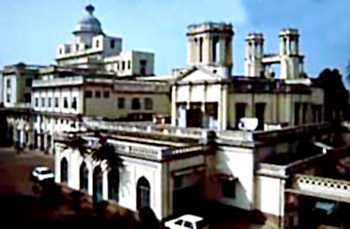 Nawabi architecture in Lucknow is quite grand and it is the most prominent architectural style seen all over the city. Despite their limited resources, the Nawabs were passionate builders and within a short span of time the city was adorned with stately edifices, palaces, pleasure pavilions with gardens, bazaars, katras and mosques. Materials such as marble and sandstone of the Mathura and Sikri varieties were scarcely used. The buildings were constructed with Lakhauri bricks and lime mortar, and decorated with stucco and plaster, occasionally carved in relief with floral and geometric motifs, and colourfully painted. Therefore, the buildings of Lucknow cannot be justly compared in their appearance and finish, with the lustrous Mughal masterpieces of Agra and Delhi.
Nawabi architecture in Lucknow is quite grand and it is the most prominent architectural style seen all over the city. Despite their limited resources, the Nawabs were passionate builders and within a short span of time the city was adorned with stately edifices, palaces, pleasure pavilions with gardens, bazaars, katras and mosques. Materials such as marble and sandstone of the Mathura and Sikri varieties were scarcely used. The buildings were constructed with Lakhauri bricks and lime mortar, and decorated with stucco and plaster, occasionally carved in relief with floral and geometric motifs, and colourfully painted. Therefore, the buildings of Lucknow cannot be justly compared in their appearance and finish, with the lustrous Mughal masterpieces of Agra and Delhi.
The artists seemed to have discarded the use of stone or marble, the building materials hitherto mainly employed, and reverted to a brick and rubble foundation faced with stucco, by which means they were able to produce architectural projects of great size and imposing appearance but at considerably less cost, expenditure of effort, and in a shorter space of time. In using this technique the artisans displayed exceptional technical skill, and the delicate execution of ornamental details and mouldings, consisting mostly of foliated and incised designs, gradually became the redeeming feature of Nawabi architecture.
The master builders of Lucknow achieved proficiency in their work. The stucco ornamentation used in Lucknow was partly composed of mother of pearl and shells deposited in lake beds, and its shine was finer than that of marble. The stability and strength of the brick masonry and plasterwork was so great that a wall could only be shattered after heavy shelling.
Lucknow`s architectural style therefore assumed its own distinctive characteristics. The sculpted patterns, painted decorations and bold stucco relief on the facade, cornices and interior surfaces of buildings constituted the impressive revival of an art which thrived in the Deccani Kingdom in the seventeenth century. Among the ornamental motifs, the most prominently and extensively used was that of the fish.
Most of the domes were crowned by gilded copper, gold-plated or terracotta-coloured finials. The lower portions of the domes were in the foliated form of the Awadh crown and some of the finials were superimposed by a Chatr or Chhatar (canopy) as in the case of Chhatar Manzil. This embellishment was also frequently used in the buildings of Rampur. Balustrades of terracotta were also a special feature of Lucknow`s monuments.
So were flying buttresses on the top of many square buildings.
The gateways of Lucknow are yet another impressive feature of its architecture. Usually erected as entrances to monumental complexes and pleasure gardens, these remarkable structures consist of recessed arches rising from the same base, and covered with arabesque details.
Other notable features are the massive vaulted roofs, the hidden cells or labyrinths and subterranean chambers and Baolis (step-wells). The multiple underground chambers of the Asafi Imambara and the subterranean chambers of Chhatar Manzil remain unparalleled.
Another notable aspect of Lucknow`s architecture was the landscaping around monuments, which had made it a city of gardens and parks. Most of them have been ravaged by time but some of their ornamental gateways and enclosures bear testimony to their erstwhile beauty and grandeur. Contemporary accounts and travelogues also describe the charm and splendour of the monuments and gardens.




